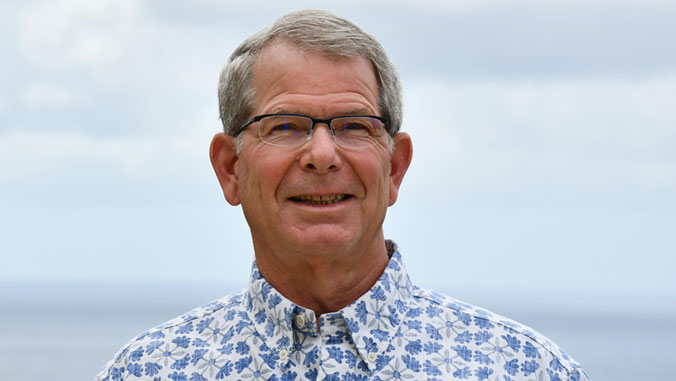
An emeritus professor in the Department of Earth Sciences at the University of Hawaiʻi at Mānoa, was honored by the Asia-Oceania Geosciences Society with the Wing Ip Medal “for his unselfish cooperation and leadership in geoscience in the Asia Oceania region.”
For more than 45 years, Gregory Moore has been studying Asian geology—mapping the structure and stratigraphy of deep sea trenches, subduction zones, mud volcanoes and more. He was a UH Mānoa professor in the School of Ocean and Earth Science and Technology from 1989 to 2020. Previously, he was an associate professor at the University of Tulsa and an assistant research geologist at Scripps Institution of Oceanography.
Throughout his research, Moore has worked with organizations such as the Indonesian Institute of Sciences, Geological Survey of Indonesia, Philippine Bureau of Mines and Geology, Japan Agency for Marine-Earth Science and Technology, University of Tokyo, National Taiwan University, Myanmar Geoscience Society and the Earth Observatory of Singapore and their staff, who assisted with logistics and accompanied Moore in the field and on research cruises.
“The continued success of my field-based studies has only been possible with the assistance, participation and local knowledge of numerous colleagues from Indonesia, the Philippines, Taiwan, Japan, Myanmar and New Zealand, all of whom I thank profusely,” said Moore.
Mapping Asia Oceania region
During graduate school at Cornell University, Moore spent three field seasons mapping the structure and stratigraphy of Nias Island, Indonesia. During his time at Scripps, he jointly led a marine geophysical cruise to the Sunda Trench offshore Java and Sumatra and conducted land field work in Indonesia and Philippines; and jointly led a seismic cruise to the Taiwan collision zone.
Moore began a decades-long investigation of the Nankai Trough subduction zone in 1987 on a joint cruise with colleagues from Tokyo University and the University of Texas and collaborative analyses of seismic data collected by Japanese colleagues. While continuing with Nankai studies, he also investigated mud volcanoes in the Rakhine State of Myanmar, joined an expedition to the Hikurangi margin of New Zealand and is now analyzing a 3D seismic data set from Hikurangi.
“It is very nice to have the recognition of a regional Geoscience Society for my continued work in South East Asia and its relevance, not only to subduction zone science, but also to ‘capacity building’ in the region,” said Moore. “By working with young scientists and passing on our experience, we increase their ability to conduct their own research to better understand their countries’ natural hazards and natural resources.”
This work is an example of UH Mānoa’s goal of Excellence in Research: Advancing the Research and Creative Work Enterprise (PDF), one of four goals identified in the 2015–25 Strategic Plan (PDF), updated in December 2020.
–By Marcie Grabowski

